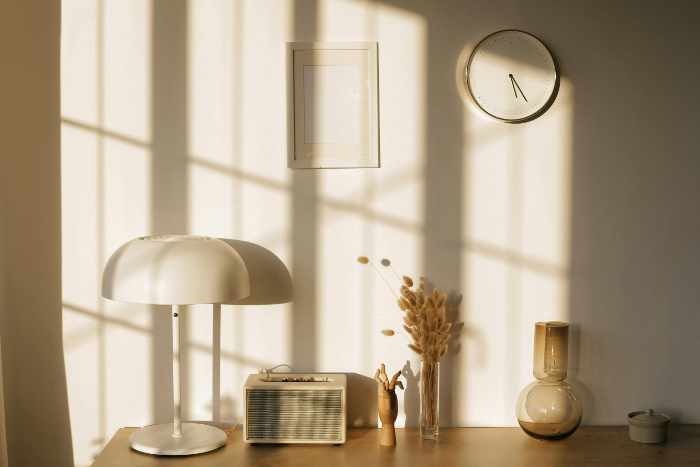Natural light has a profound impact on the ambiance and mood of a home. It makes spaces feel larger, more welcoming, and vibrant. Additionally, increased natural light can have significant benefits for your health and well-being, such as boosting your mood and increasing productivity. Today we’re looking at perhaps the four top ways to increase natural light in your home.

Many homes lack adequate natural light, relying heavily on artificial sources. But that’s no way to live. Instead, let’s transform dark, dim spaces into bright, airy environments that people enjoy living in.
4 Surprising Ways to Increase Natural Light in Your Home
Here are four surprising but effective ways to increase natural light in your home.
1. Optimize Window Treatments
Another effective way to increase natural light in your home is to optimize your window treatments. The type of window coverings you use can significantly impact the amount of sunlight that enters your living spaces. Heavy, dark curtains can block out much of the natural light, making rooms feel darker and smaller. Instead, opt for lighter, more translucent materials that allow sunlight to filter through. This will also make your small space look bigger.
Sheer curtains are an excellent choice for maximizing natural light while still providing privacy. These curtains let in a soft, diffused light that brightens the room without the harsh glare of direct sunlight. Pairing sheer curtains with light-colored blinds or shades can offer additional control over the amount of light entering your home.
If you prefer a more minimalist look, consider using window films. These films can reduce glare and UV exposure while still allowing a significant amount of light to pass through. They are available in various designs, from clear to frosted or patterned, offering both functionality and style.
In addition to window treatments, the windows themselves play a crucial role in the amount of light entering your home. If you have old or inefficient windows, you might consider upgrading to newer models. Installing larger or additional windows can dramatically increase natural light. Replacement windows are an investment that can help enhance the overall brightness of your space while also lowering your electricity bills.
When choosing window treatments and considering window replacements, always keep in mind the direction your windows face. South-facing windows typically receive the most sunlight throughout the day, while north-facing windows get softer, more consistent light. By understanding the light patterns in your home, you can make informed decisions that maximize natural illumination.
2. Use Mirrors to Reflect Light
Designers who understand the art of home remodeling know when and where to use mirrors. They can be a powerful tool in your quest to enhance natural light in your home. By strategically placing mirrors in key locations, you can reflect sunlight deeper into your rooms, making them appear brighter and more spacious. The principle behind this is simple: mirrors bounce light around a room, amplifying the amount of natural light present.
To make the most of mirrors, consider positioning a large mirror opposite or adjacent to a window. This placement will catch the light coming in and reflect it across the room, effectively doubling the amount of sunlight. Full-length mirrors are particularly effective in hallways and narrow spaces, where they can significantly enhance brightness.
Moreover, mirrored furniture and decor can subtly increase the light in a room. Items, like mirrored coffee tables, wall art, and light fixtures, can contribute to a brighter environment without overwhelming the aesthetic of your space. Reflective surfaces, such as glass and metallic finishes, also work well in this regard.
For an even greater effect, consider creating a mirror gallery wall. This arrangement not only adds a decorative element to your room but also maximizes light reflection. Combining mirrors of different shapes and sizes can create an interesting visual impact while serving a functional purpose.
Remember, the placement of mirrors should be intentional. Avoid placing them where they might cause glare or reflect unwanted views. With careful positioning, mirrors can be one of the simplest yet most effective ways to boost natural light in your home.
3. Embrace Lighter Colors
Color has a significant impact on how light interacts with your home’s interior. Dark walls and furnishings can absorb light, making rooms feel smaller and gloomier. On the other hand, lighter colors reflect light, enhancing brightness and creating a more open, airy atmosphere.
When painting your walls, opt for light, neutral shades such as whites, creams, and soft pastels. These colors are excellent at reflecting light, which helps to distribute it more evenly throughout the room. If you prefer a bit more color, consider using light blues, greens, or yellows, which can add a cheerful touch while still promoting brightness.
In addition to wall colors, consider the color of your ceilings and floors. Painting the ceiling a bright white can give the illusion of higher ceilings and enhance the overall light in the room. Light-colored flooring, such as pale wood, white tiles, or light-colored carpets, can also reflect light upward, contributing to a brighter environment.
Your choice of furniture and decor should also lean towards lighter hues. Opt for sofas, chairs, and tables in light, neutral tones. If you have dark furniture, you can lighten the look with light-colored throws, cushions, and area rugs. These small touches can make a significant difference in reflecting light and enhancing the overall brightness of your home.
4. Use Skylights and Solar Tubes
Skylights and solar tubes are excellent solutions for bringing more natural light into areas of your home that may not have direct access to windows. These installations can dramatically transform dark, enclosed spaces such as hallways, bathrooms, and closets by flooding them with sunlight.
Skylights are essentially windows installed on the roof, allowing daylight to stream directly into the room from above. They are particularly effective in spaces with high ceilings or in attics converted into living areas. Skylights not only increase natural light but also provide an opportunity for ventilation, which can improve air quality and reduce humidity.
There are various types of skylights to choose from, including fixed, vented, and tubular designs. Fixed skylights are stationary and do not open, making them a good choice for areas where additional ventilation is not needed. Vented skylights can be opened to allow fresh air in, which is ideal for kitchens and bathrooms. Tubular skylights, also known as solar tubes, are smaller and less invasive, making them perfect for tight spaces where traditional skylights may not fit.
Solar tubes are an innovative way to channel sunlight into your home. These tubes capture sunlight on the roof and direct it through a reflective tunnel, dispersing natural light into the room below. They are particularly effective for interior rooms that lack windows and for homeowners who want a cost-effective and minimally invasive way to increase natural light.
When considering skylights or solar tubes, it’s important to choose the right size and placement for maximum effectiveness. Consult with a professional installer to determine the best locations and types for your home. Proper installation is crucial to prevent leaks and ensure energy efficiency.
Conclusion
Increasing natural light in your home can have a profound impact on the atmosphere and overall well-being of its inhabitants. From using mirrors and optimizing window treatments to embracing lighter colors, keeping windows clean, and installing skylights or solar tubes, there are numerous ways to brighten your living spaces.
By implementing these strategies to increase natural light in your home, you can create a more inviting, vibrant, and healthy environment in your home. Embrace the power of natural light to enhance your home’s aesthetic appeal and improve your quality of life.



